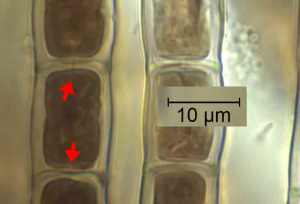A recurring theme of this blog has been that the process of “seeing” is one that requires a mind that is preconditioned to process the signals passed to it from the optic nerve. For much of the natural history that we see on a country walk, that link is already in place: we notice trees, birds, butterflies and so on, even if we can’t always put a name on what we are looking at. That means that natural history becomes a closed loop: noticing birds means we are more likely to notice differences amongst birds – whether in type or habit or the timing of their visits – which, in turn, stimulates greater mental awareness. But not noticing something is equally self-perpetuating and many of my posts have focussed on the natural history that most of us routinely overlook.
A good reason for not noticing aspects of natural history is that the organisms in question do not even look “alive” in the first place. Another is that they are so tiny that they are either microscopic or only just apparent with the naked eye. As this post deals with a group of algae that fit both of these criteria, you can be forgiven for not knowing about these organisms before, but also for wondering what kind of person scratches away at submerged stones in the counterintuitive hope of finding life.
Earlier posts have talked about algae that form crusts on rocks, such as the red algae Hildenbrandia rivularis(see “More about red algae”) or the cyanobacteria of the genus Chamaesiphon (see “A bigger splash …”). Chamaesiphon tends to form brown to almost black spots on rocks but there is one other type of alga that also forms dark brown patches of rock in streams that I have not previously written about. This is the brown alga Heribaudiella fluviatilis. Most of the brown algae are marine and largely beyond the scope of this blog (but see “Swimming in a sea of ignorance”) and there are just two genera recorded from UK freshwaters. Both are rarely recorded, but probably more common than we think. I’ll come back to this later in the post, but freshwater brown algae really do encapsulate the conundrum in the first paragraph: not noticing becomes self-perpetuating as we repeatedly fail to realise that there is something we ought to notice.
The photos at the top of the post – taken by Wolfgang Schülz in Germany – show characteristic colonies of Heribaudiella fluviatilis, with distinct margins, in contrast to Chamaesiphon crusts, whose margins are less clearly delimited. The best way to confirm that you are looking at Heribaudiella rather than Chamaesiphon, however, is to scrape up the crust and examine it under a microsope. Then the characteristic cells arranged in short filaments, each with several yellow-brown chloroplasts, should be obvious.

The late Nigel Holmes was good at spotting Heribaudiella colonies (which can be just a couple of millimetres across) on stones in rivers but the ability (or, perhaps, the inclination) to notice these has declined thereafter. We know it is out there because the primers we use for molecular studies of diatoms also appear to pick up Heribaudiella as by-catch, and we were surprised at how often it appeared. Curiously, these primers also differentiated between Heribaudiella and another brown algal genus, Bodenella. I wrote about Bodenella in Depths of Imagination and also mentioned that there was some dispute about whether this was truly distinct from Heribaudiella. Last summer, I revisited a stream from which this “Bodenella” was recorded but failed to get enough material to make a satisfactory examination of its microscopic features. The jury is out on this, especially as the habitats where we’ve detected “Bodenella” are so different to the locations where it has been securely identified elsewhere in Europe. Personally, I would be reluctant to add this as a new UK record without having backed up a molecular identification with some more traditional taxonomy.
Having noticed that we’re not noticing Heribaudiella fluviatilis, one of the best arguments for stimulating interest in this organism is that it tells us useful information about the state of the stream in which it is growing. Most of the chemical data describing its habitat that I’ve seen would suggest that it prefers “good status” water and is, thus, a sign that the ecosystem is healthy. In the final analysis, though, records of Heribaudiellaprobably say more about the quality of the observer than of the habitat.
References
Koletić, N., Alegro, A., Vuković, Rimac, A. & Šegota, V. (2018). Spotting the spots: the freshwater brown algaHeribaudiella fluviatilis (Areschoug) Svedelius within stream communities of southeastern Europe. Cryptogamie, Algologie 39: 449-463.
(this paper, interestingly, notes an association between Heribaudiella and Hildenbrandia that is also discussed in Depths of Imagination)
Wehr, J.D. (2011). Phylum Phaeophyta. pp. 354-357. In: The Freshwater Algal Flora of the British Isles(edited by D.M. John, B.A. Whitton & A.J. Brook). Cambridge University Press, Cambridge.
Wehr, J.D. & Stein, J.R. (1985). Studies on the biogeography and ecology of the freshwater phaeophycean alga Heribaudiella fluviatilis. Journal of Phycology 21: 81-93.
The work that we described in Depths of Imagination was recently published:
Schülz, W., Kelly, M.G., King, L. & Cantonati (2021). Did Zebra mussel fill the type habitat of a worldwide-rare freshwater brown macroalga? Aquatic Conservation: Marine and Freshwater Ecosystems 31: 3657-3659.
Wrote this whilst listening to: Hildegaard of Bingen, and Nick Cave’s Murder Ballards.
Currently reading: Pen Vogler’s Scoff, about the history of British food.
Cultural highlight: Munich: Edge of War – film based on Robert Harris’ book set around the Munich crisis of 1938 and starring George Mackay and Jeremy Irons.
Culinary highlight: mutton steak from our local organic butcher, with homemade chips and peppercorn sauce.









